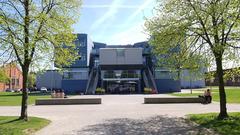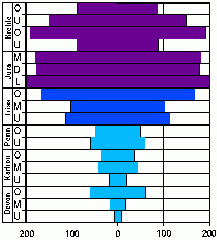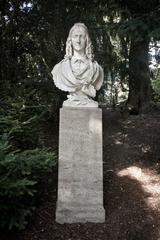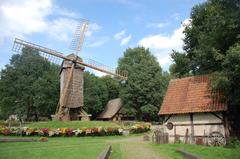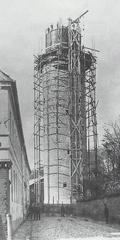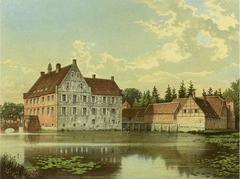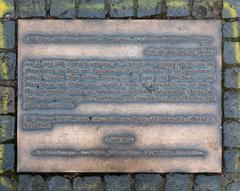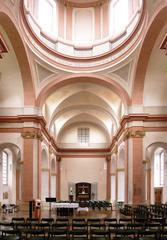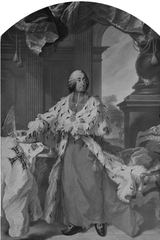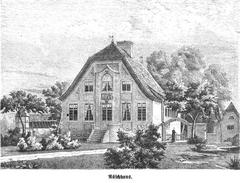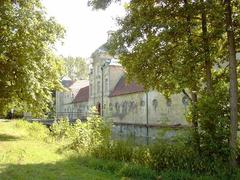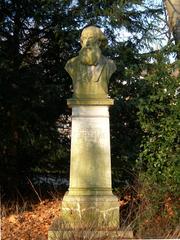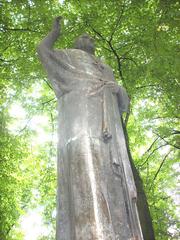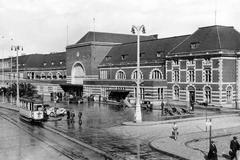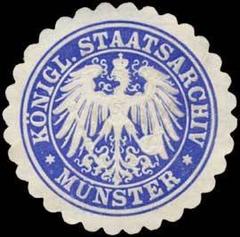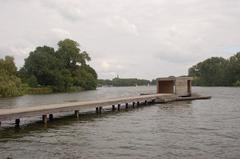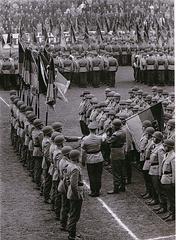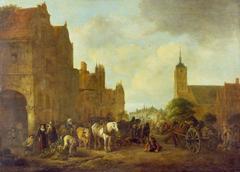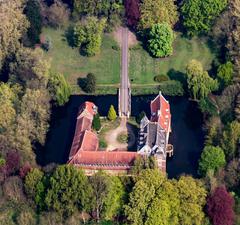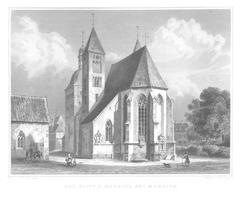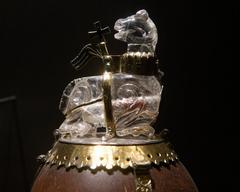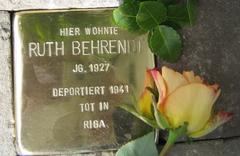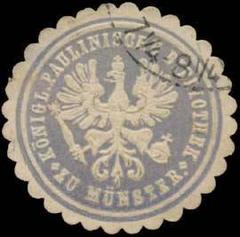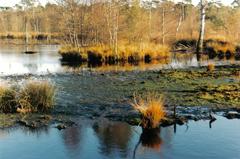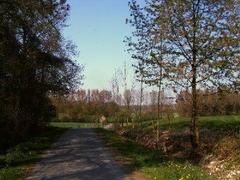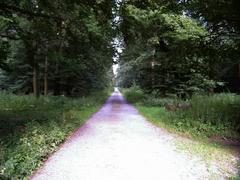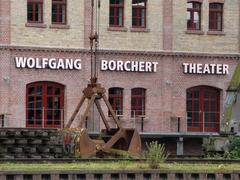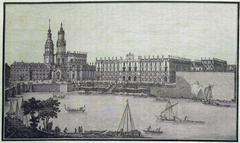Domstift Münster Visiting Hours, Tickets, and Historical Sites Guide
Date: 15/06/2025
Introduction
Domstift Münster, also known as St. Paulus Dom or Münster Cathedral, is an iconic monument at the heart of Münster, Germany. With origins tracing back to the early medieval period, this cathedral embodies more than a millennium of ecclesiastical history, evolving from its monastic foundation into a grand Romanesque and Gothic masterpiece. Located centrally on Domplatz, it offers visitors a unique window into the spiritual, architectural, and cultural legacy of Münster. Today, it remains an active place of worship, a guardian of sacred art, and a must-see destination for every visitor to the city (Geschichtsverein Münster; Stadt Münster; Spotting History).
Contents
- Early Origins and Historical Development
- Architectural and Artistic Highlights
- Religious and Cultural Significance
- Visiting Hours, Tickets, and Accessibility
- Guided Tours and Visitor Experience
- Nearby Attractions
- Practical Tips for Your Visit
- Frequently Asked Questions (FAQ)
- Conclusion
Early Origins and Historical Development
The origins of Domstift Münster date to the 9th century, with the earliest references found in the records of Lorsch and Fulda monasteries. The cathedral’s name, “Münster,” is derived from the Latin “monasterium,” reflecting its early function as a monastic foundation. Over time, it evolved into a prominent collegiate church, or “Stift,” endowed with lands and resources and managed by canons who lived as clergy but retained private incomes (Geschichtsverein Münster).
By the late 10th century, Emperor Otto III granted the region to the Worms Cathedral Chapter, and in 1194, the Premonstratensian Abbey of Arnstein assumed administration. This transition marked Münster as a religious and administrative hub for the Laubusbach valley, setting the stage for centuries of ecclesiastical influence (Geschichtsverein Münster).
Architectural and Artistic Highlights
Romanesque and Gothic Fusion
The existing cathedral, constructed primarily in the 13th century, is a harmonious blend of Romanesque and Gothic architecture. The twin west towers, dating from the late 12th century, are hallmarks of Romanesque strength, while the soaring nave, ribbed vaults, and pointed arches exemplify Gothic elegance (Trek Zone; Spotting History).
The Astronomical Clock
A highlight for visitors is the cathedral’s 16th-century astronomical clock, renowned for its counterclockwise movement and daily mechanical procession of apostle figures at noon (12:30 p.m. on Sundays and holidays). This Renaissance marvel displays not only the time but also lunar phases, religious feast days, and zodiac signs, representing a unique confluence of faith and science (WhichMuseum; Europe for Visitors).
Stained Glass, Sculpture, and Treasury
The cathedral’s interior is enriched by luminous stained glass windows, many of which were restored after World War II, depicting vibrant biblical scenes. The treasury (Domschatz), located north of the cloisters, houses over 700 sacred objects, including medieval vestments, gold brocade, and liturgical artifacts from the Carolingian era onward (Wikipedia). Sculptural highlights include Baroque altarpieces and works by Johann Brabender, testifying to centuries of artistic renewal.
Religious and Cultural Significance
Domstift Münster has been a central player in European religious and political life for centuries. As the seat of the Bishop of Münster, it has hosted major ecclesiastical events and served as a focal point for the city’s spiritual and civic identity. The cathedral was closely linked to the Peace of Westphalia negotiations in 1648, a turning point in European history (Stadt Münster). The tomb of Clemens August Graf von Galen, who opposed the Nazi regime, underscores the cathedral’s enduring role as a symbol of moral courage and resilience (Trek Zone).
Visiting Hours, Tickets, and Accessibility
Visiting Hours
- Monday–Saturday: 9:00 AM–6:00 PM
- Sunday & Holidays: 12:00 PM–6:00 PM
- During religious services and special events, visiting hours may vary. Always check the official cathedral website for current information.
Admission and Tickets
- Cathedral Entry: Free (donations appreciated).
- Treasury and Special Exhibitions: Tickets required (€5 adults, €3 reduced).
- Guided Tours: Available for a fee (typically €8 per person); English-language tours on weekends and holidays (WhichMuseum).
Accessibility
- The cathedral is wheelchair accessible via ramps at the main entrance.
- Accessible restrooms and assistance are available.
- Some historic areas (crypt, upper galleries) may have limited access.
Guided Tours and Visitor Experience
Guided tours, available in several languages, offer in-depth perspectives on the cathedral’s history, art, and architecture. Tours can be booked through the Münster Information office or the official website. Audio guides and multilingual printed materials are also provided for self-guided exploration (Tourispo.de).
Highlights not to miss:
- The daily procession of the astronomical clock at noon
- The Paradise Narthex and Apostles’ statues
- The peaceful cloisters and cathedral gardens
Nearby Attractions
Domstift Münster is perfectly situated for exploring Münster’s other historical and cultural sites:
- Prinzipalmarkt: The city’s iconic arcaded marketplace, lined with historic facades and shops (Europe for Visitors)
- Historical City Hall: Site of the Peace of Westphalia negotiations (The Crazy Tourist)
- St. Lambert’s Church: Known for the Anabaptist cages hanging from its tower (Britannica)
- LWL Museum of Art and Culture: Showcasing regional and international art
On Wednesdays and Saturdays, Domplatz hosts a bustling market with local produce, flowers, and crafts (Münsterland.com).
Practical Tips for Your Visit
- Best Times: Weekday mornings or late afternoons are generally quieter.
- Dress Code: Modest clothing is recommended, especially during religious services.
- Photography: Allowed in most areas (no flash or tripods); restrictions may apply in the treasury and during services.
- Facilities: Restrooms and a small gift shop are available; nearby cafés and bakeries offer refreshments.
- Family-Friendly: The astronomical clock fascinates children, and educational materials are often provided.
Frequently Asked Questions (FAQ)
Q: What are the Domstift Münster visiting hours?
A: Monday–Saturday 9:00 AM–6:00 PM; Sunday and holidays 12:00 PM–6:00 PM. Hours may vary during services or events.
Q: Is there an admission fee?
A: Entry to the cathedral is free; treasury and guided tours require tickets.
Q: Are guided tours offered in English?
A: Yes, especially on weekends and holidays. Advance booking is recommended.
Q: Is the cathedral wheelchair accessible?
A: Yes, most main areas are accessible. Some historic sections may have limited access.
Q: Can I take photos inside?
A: Yes, but no flash or tripods; restrictions apply during services and in the treasury.
Conclusion
Domstift Münster is a living monument—a harmonious blend of Romanesque strength and Gothic grace, steeped in history and alive with spiritual and cultural activity. Free entry, accessible facilities, and the opportunity for guided tours make it welcoming for all. With its central location, vibrant surroundings, and ongoing role in Münster’s community, the cathedral promises a memorable visit for every traveler. For up-to-date information, download the Audiala app, explore related articles, and follow Münster’s cultural happenings online.
Summary and Visitor Recommendations
Visiting Domstift Münster is a journey through centuries of faith, architecture, and European history. With its iconic twin towers, resplendent interiors, and the world-famous astronomical clock, the cathedral anchors Münster’s rich heritage. Plan your visit during quieter times, enjoy a guided tour, and explore the markets and museums nearby for a full cultural experience. Stay informed with the latest updates via the Audiala app and city tourism resources (Wikipedia; Europe for Visitors; germany.travel).
Sources and Further Reading
- Geschichtsverein Münster
- Stadt Münster
- Spotting History
- Wikipedia
- Europe for Visitors
- germany.travel
- Trek Zone
- WhichMuseum
- Tourispo.de
- Münsterland.com
- The Crazy Tourist
- Britannica
- Explorial
